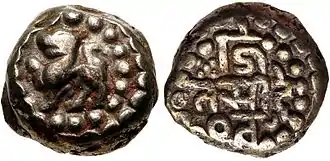Narasimhavarman I
Narasimhavarman I or Narasimha Varma I[1] was a king of the Pallava dynasty who ruled South India from 630–668 AD. He shared his father Mahendravarman I's love of art and completed the work started by Mahendravarman in Mamallapuram. During his reign famous Pancha Rathas Temple was constructed which is Rock Cut Temple, a UNESCO World Heritage site.
| Narasimhavarman I | |
|---|---|
| Pallava King | |
| Reign | c. 630 – c. 668 AD |
| Predecessor | Mahendravarman I |
| Successor | Mahendravarman II |
| Issue | Mahendravarman II |
| Dynasty | Pallava |
| Father | Mahendravarman I |

| Pallava Kings (200s–800s) | |
| Virakurcha | |
| Vishnugopa II | |
| Simhavarman III | |
| Simhavishnu | |
| Mahendravarman I | (600-630) |
| Narasimhavarman I | (630–668) |
| Mahendravarman II | (668–670) |
| Paramesvaravarman I | (670–695) |
| Narasimhavarman II | (700-728) |
| Paramesvaravarman II | (728–731) |
| Nandivarman II | (731–795) |
| Dantivarman | (795–846) |
| Nandivarman III | (846-869) |
| Nrpatungavarman | (869-880) |
| Aparajitavarman | (880-897) |
He avenged his father's defeat at the hands of the Chalukya king, Pulakeshin II in the year 642 AD . Narasimhavarman I was also known as Mahamalla[2][3] (great wrestler), and Mamallapuram (Mahabalipuram) was named after him.
It was during his reign, in 640 AD, that the Chinese traveller Hiuen Tsang visited Kanchipuram.[4]
Narasimhavarman I was a devotee of Shiva. The great Nayanar saints like Appar, Siruthondar and Tirugnanasambandar lived during his reign.
Narasimhavarman I was succeeded by his son Mahendravarman II in the year 668 AD.
Military conquests
Narasimhavarman I is claimed to be one of the 12 Indian kings who never lost on the battlefield to their enemies, the others being Ajatashatru, Chandragupta Maurya, Karikala Chola, Cheran Senguttuvan, Sri Krishnadevaraya of Vijayanagar empire, Chola king Rajasuyam Vaetta Perunarkilli (575 BC), who successfully completed military Rajasuyam sacrifice, Pandyan Nedunchezhian of the Sangam age, Samudragupta, great Pallava Nayanmar saint Rajasimha, Rajaraja Chola I, his great warrior son Rajendra Chola .
War with the Chalukyas
Pulakeshin II, a deccan king, had previously raided various northern Pallava provinces and forts. However, he was unable to capture the Pallava capital of Kanchipuram.[5] This led to a long conflict between the Chalukyas and the Pallavas.
Pulakeshin II again attempted to seize the Pallava capital and undertook another expedition several years later. However, the Pallava reign had moved on to Narasimhavarman I by then. Narasimhavarman defeated the Chalukyas in several battles, including one at Manimangalam 20 miles to the east of Kanchipuram. The king states that he could see the back of his dreaded enemy as he tore apart his army. Encouraged by this victory, Narasimhavarman led his army along with his general Paranjothi and invaded Vatapi, successfully defeating[4] and killing the Chalukya king Pulakeshin II in 642 CE. The city was never a capital again.[6]
He returned victorious to Kanchipuram, and was given the title Vatapikondan (one who conquered Vatapi).[7]
His general Paranjothi (a Vikrama Kesari, also known as paradurgamarddana) was known very well for his devotion to Lord Siva and as one of the 63 Nayanmar saints, is said to have indeed personally destroyed the city of Vatapi under the command of Narasimhavarman I. Sekkizhaar's work 12th tirumurai credits this siruttondar of having destroyed the evil kali as manifested by the deccan enemy of pallavas. He is also known as 'Siruthonttar', a dutiful warrior and a practicing medic who had "mastered several treatises in medicine". This vikramakesari had at the insistence of Lord Sivan sacrificed his child without any qualms. There was a confusion as to whether the Ganesha at a temple in Chengattankudy could have been a result of this invasion. Many grants refer to this event as: "kilisayoneriva vimattita vathapi" or the one who destroyed Vatapi, the same way Sage Agastya had killed a demon by that name long ago.(**)
Influence on Sri Lankan politics
The Sinhalese prince Manavarma lived at the court of Narasimhavarman and had helped him crush his enemy Pulakeshin II. In return, Narasimhavarman had helped Manavarma twice with an army to invade Sri Lanka. The second attack was successful. Manavarma occupied Sri Lanka, over which he is supposed to have ruled from A. D. 691 to 726. The Kasakudi copper plates refer to Narasimhavarman's conquest of Sri Lanka. The Mahavamsa also confirms these facts.
Narasimhavarman in literature
Kalki Krishnamurthy's work, Sivagamiyin Sabadham, is based on Narasimhavarman's early years and his battles with the Chalukyas. Kalki Krishnamurthy's Parthiban kanavu is based on the later years of Narasimhavarman's rule.
Narasimhavarman I | ||
| Preceded by Mahendravarman I |
Pallava dynasty 630–668 |
Succeeded by Mahendravarman II |
Notes
- Journal of the Royal Asiatic Society of Great Britain and Ireland. Royal Asiatic Society of Great Britain & Ireland. 1885.
- Rabe, Michael Dan (1987). The Monolithic Temples of the Pallava Dynasty: A Chronology. University of Minnesota.
- Gangoly, Ordhendra Coomar (1957). The art of the Pallavas. G. Wittenborn.
- Sen, Sailendra (2013). A Textbook of Medieval Indian History. Primus Books. pp. 41–42. ISBN 978-9-38060-734-4.
- Keay, John, India: A History, p170
- KAN Sastri, A History of South India, p136
- Keay, John, India: A History, p172
References
- Keay, John (2001). India: A History. Grove Press. ISBN 0-8021-3797-0.
- Sastri, K A N (2008). A History of South India (4th ed.). New Delhi, India: Oxford University Press.
(**) Ancient India, R. C. Majumdar, Ancient India, K.A.Nilakanta Sastri